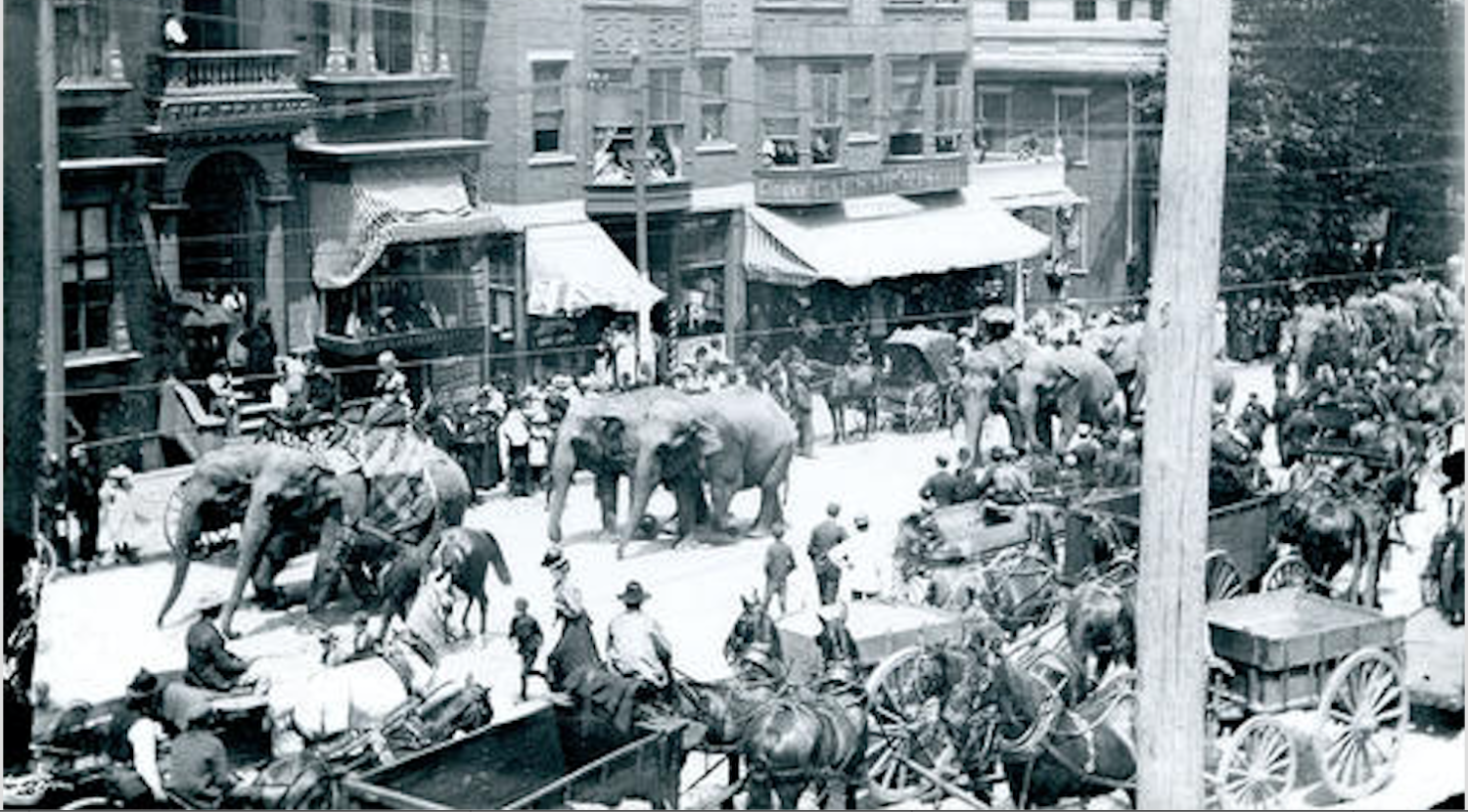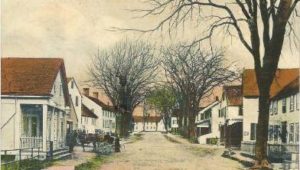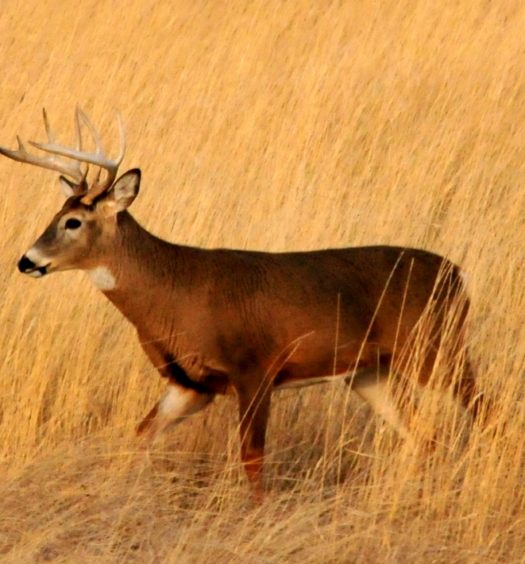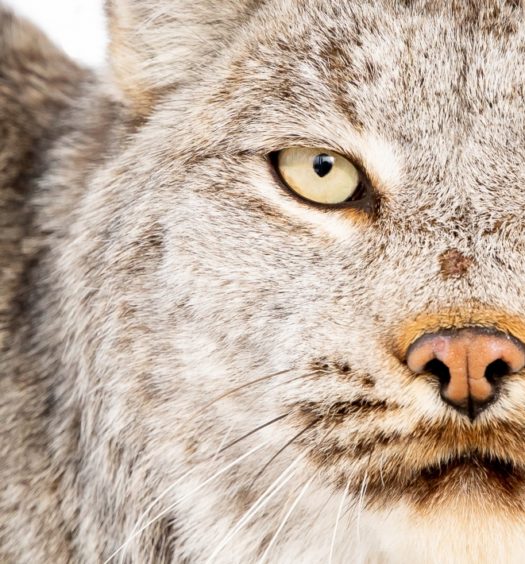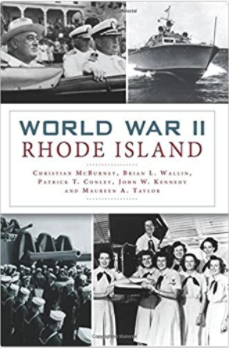[Author’s note: By the 1820s, circuses were becoming a popular form of mass entertainment. Traveling from small town to small town, they attracted increasingly large crowds. The first elephants from Africa and India were carried on ships to America and began to be shown in small circuses around the country. Imagine the wonder of seeing a magnificent elephant with one’s own eyes in the 1820s!
Sadly, the first two of three elephants that arrived in the United States by ship from India were murdered. The first one, an Indian elephant called Big Bett, was brought to America on a sailing ship in 1796. He was shot and killed in 1816 in Alfred, Maine, by a religious fanatic after he objected to the interference of his Sabbath when Big Bett’s keeper walked the elephant across his field.
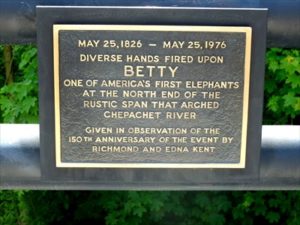
On May 25, 1976, the town of Chepachet placed this plaque on the bridge where Little Bett was killed 150 years earlier. The plaque is on the bridge where Route 44 crosses the Chepachet River, just south of 1178 Putnam Pike in Chepachet.
The second killing of an elephant, to our state’s great shame, occurred in Rhode Island in 1826. The elephant’s name was Betty the Fabulous Learned Elephant (or, affectionately, Little Bett). Little Bett was widely loved by audiences on the East Coast from the Carolinas to Maine.
Little Bett first visited Chepachet in 1822. Little Bett arrived at Chepachet the night before her show. The 6,000 pound (or so) elephant was placed inside a tent, requiring patrons to pay 12 1/2 cents for admission to the tent to view the spectacle (children under twelve, were charged half price). When Little Bett returned to Chepachet in 1826, she was just twelve-years-old, a young child for an elephant.
The following is a letter to the then young Providence Journal that provided the heart-breaking background facts.]
From the Providence Journal, June 1, 1826
Chepachet, May 28, 1826
Sir. Thinking it probable that some particulars of the diabolical transactions which took place in this village [Chepachet] on Thursday morning last, in the slaughter of the Elephant, I send you the following, collected from authentic sources.
The keepers, having obtained a license from the proper authority, exhibited the animal last Wednesday, at Angell’s Hotel, and no dissatisfaction was publicly manifested during the day. Between 12 and 1 o’clock at night, the elephant was taken from the stable, and started for Smithfield, northerly, accompanied by a leader on foot, and two attendants on horseback, and followed by a small number of citizens of different ages.
When arrived at the northern extremity of the bridge in the center of the village, two muskets or rifles were discharged in quick succession, apparently from a window of an apartment in the grist mill, within nine yards of the animal’s head. Five bullets from the first pierced the frontal bone of the animal to the brain, and two from the other took effect in the neck, near the collar, and within two feet of the leader and very near some spectators. The noble beast fell, and instantly expired. Such was the consternation produced by the terrifying and fatal catastrophe that immediate pursuit of the bloody actors was not thought of and they escaped.
As soon as the neighbors collected at the morning dawn, the sensation of indignation was electric—regret and execration were depicted in every countenance. A subscription was immediately filled to aid in the arrest and conviction of the villain of villains, who committed the high handed and daring crime.
The perpetrators of this wanton act, we are happy to state, are fully discovered. Some circumstances having fastened suspicion upon two individuals, they were privately examined, and finally induced to make a disclosure ore the whole transaction, which was subsequently repeated on examination before a Court of Justices, Judge Branch of this town presiding.
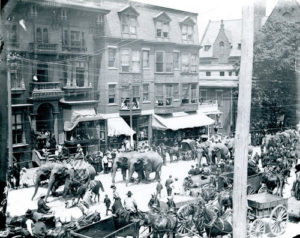
Circus elephants on parade, with spectators lining both sides of Westminster Street and from windows in buildings. Undated, perhaps around 1895 (Providence Public Library Digital Collections)]
From this investigation it appears that there were six persons engaged in the affair: Fenner Eddy, John Inman, Albert Eddy, Francis West, Angell Darling, and Benjamin Bowen. Three guns were to be used. Angell Darling loaded two, one with seven and the other with two bullets; the other with gun was loaded by Albert Eddy with five bullets. Fenner Eddy and [John] Inman stationed themselves in the [grist] mill, with the three guns, expecting to be joined by a third person who, however, did not appear. West and Bowen gave them notice of the starting and the approach of the Elephant at two separate times. Bowen told them if there was no man in the way to shoot the elephant wherever they could hit her. Just as the animal was leaving the bridge, Fenner Eddy fired the gun with seven bullets, and as she [the Elephant] was falling, [John] Inman discharged his gun with two bullets. Fenner [Eddy] then threw his gun into the room, seized the gun which had not been discharged, being afraid the dog [accompanying the Elephant] might attack him. They made their escape, and soon after mingled with the persons collected on the bridge, where their accessories were also assembled. When the people dispersed, the gun was raked out of the room, the three guns deposited at the tan yard [where a leather tanning business was conducted], and the parties each went home.
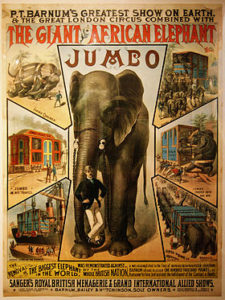
Elephants became popular circus attractions. This is a poster of Jumbo the Elephant, an African elephant born in Sudan. Jumbo was sold to P. T. Barnum, who took him to the U.S. for exhibition in March 1882. The poster shows Jumbo and his keeper Matthew Scott in about 1882. Jumbo was killed in Canada in an accident by a train locomotive.
After hearing these facts and confessions, the Court ordered the parties individually to recognize in the sum of five hundred dollars with sureties for the same amount each [note: essentially, bail]; the law which makes the killing a beast an offense, punishing the same with a fine not exceeding $100 and two months imprisonment, and also subjecting the party convicted to pay to the owner treble damages, to be recovered in an action of trespass [note: civil court case]. This [criminal ordinance] was doubtless intended to apply to ordinary animals, horses, etc. and the law could not have anticipated the shooting of an elephant.
In the whole course of this arduous investigation, which occupied more than a day, no direct motive was shown that could have induced the act. It appears to have been done thoughtlessly, out of pure love of mischief, and just for the pleasure of killing an elephant. Unfortunately, the parties involved are not men of much substance, though it is believed some part of the value of the noble animal they have destroyed may be obtained from them eventually.
[Author’s supplemental note: It should be noted that it was reported that none of the killers hailed from Chepachet itself. But most or all came from Rhode Island. Two of the bullets fired from the gun that shot a total of seven bullets missed. Fortunately, they did not strike one of the many nearby human beings.
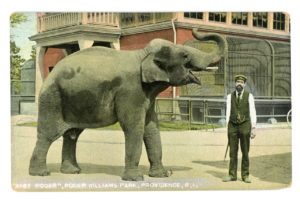
This elephant, named “Baby Roger,” was kept at Roger Williams Park about 1910 (Sanford Neuschatz Collection)
Why did these men commit this heinous crime? The author suspects they had a bet that they could kill an elephant with guns, after some idiots argued that an elephant could not be so killed. Or perhaps the men wanted credit for killing the largest animal then in North America.
The owners of Little Bett computed their loss at more than $5,000. It is doubtful the killers could have paid anything close to this amount. At this time, those who could not pay their debts were thrown into debtor’s prison. The author does not know if the convicted men were handled in this way as a result of not being able to pay off their debt.
The body of Little Bett was brought to Owens Tannery on Tannery Lane to be skineed.]]
[Banner image: Circus elephants on parade, with spectators lining both sides of Westminster Street and from windows in buildings. Undated, perhaps around 1895 (Providence Public Library Digital Collections)]

